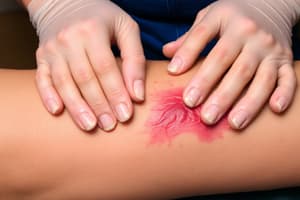Podcast
Questions and Answers
What is a characteristic manifestation of Stage 1 pressure injuries?
What is a characteristic manifestation of Stage 1 pressure injuries?
- Blood-filled blisters on the fingers
- Dark, discolored skin with pus-filled blisters
- Nonblanchable erythema of intact skin (correct)
- Intact skin with localized maroon discoloration
What symptom may indicate a Deep Tissue Pressure Injury?
What symptom may indicate a Deep Tissue Pressure Injury?
- Blisters filled with clear fluid
- Pink tissue with some discoloration
- Thin eschar on a dark wound bed (correct)
- Localized, nonblanchable maroon discoloration
In which situation can identification of pressure injuries be particularly challenging?
In which situation can identification of pressure injuries be particularly challenging?
- In patients with darkly pigmented skin (correct)
- In patients receiving anticoagulant therapy
- In patients with normal skin pigmentation
- In patients with a history of skin cancer
What may precede a Deep Tissue Pressure Injury?
What may precede a Deep Tissue Pressure Injury?
What is NOT a description of Stage 1 pressure injuries?
What is NOT a description of Stage 1 pressure injuries?
What characterizes a Stage 1 pressure injury?
What characterizes a Stage 1 pressure injury?
Which treatment is NOT appropriate for a Stage 2 pressure injury?
Which treatment is NOT appropriate for a Stage 2 pressure injury?
In pressure injuries, which tissue is usually the least resistant to pressure?
In pressure injuries, which tissue is usually the least resistant to pressure?
What is a common manifestation of a deep tissue pressure injury?
What is a common manifestation of a deep tissue pressure injury?
Which of the following is a key intervention for managing all stages of pressure injuries?
Which of the following is a key intervention for managing all stages of pressure injuries?
What does the presence of slough or eschar indicate in pressure injuries?
What does the presence of slough or eschar indicate in pressure injuries?
What treatment is recommended for a Stage 1 pressure injury?
What treatment is recommended for a Stage 1 pressure injury?
What does necrotic tissue require in the treatment of Stage 3 or Stage 4 pressure injuries?
What does necrotic tissue require in the treatment of Stage 3 or Stage 4 pressure injuries?
What factor contributes to the varying manifestations of pressure injuries?
What factor contributes to the varying manifestations of pressure injuries?
Which statement is true regarding the distribution of pressure on bony prominences?
Which statement is true regarding the distribution of pressure on bony prominences?
What is the primary objective for patients at risk for developing pressure injuries?
What is the primary objective for patients at risk for developing pressure injuries?
Which diagnostic test is particularly useful for determining the presence of osteomyelitis?
Which diagnostic test is particularly useful for determining the presence of osteomyelitis?
What is the purpose of surgical debridement in the treatment of pressure injuries?
What is the purpose of surgical debridement in the treatment of pressure injuries?
Which of the following types of debridement utilizes the body's own enzymes?
Which of the following types of debridement utilizes the body's own enzymes?
What healthcare team member's action is crucial to preventing pressure injuries?
What healthcare team member's action is crucial to preventing pressure injuries?
Which of the following lab studies should be included to assess a patient's nutritional status for wound healing?
Which of the following lab studies should be included to assess a patient's nutritional status for wound healing?
Which dressing type supports the body's natural enzymes for debridement?
Which dressing type supports the body's natural enzymes for debridement?
What is a benefit of using maggot therapy for wound debridement?
What is a benefit of using maggot therapy for wound debridement?
What should be regularly assessed when ulcers develop in patients?
What should be regularly assessed when ulcers develop in patients?
Which of the following describes a function of the secretions from fly larvae?
Which of the following describes a function of the secretions from fly larvae?
What type of dressing is preferred for deep, exudative wounds?
What type of dressing is preferred for deep, exudative wounds?
What important role does the presence of maggots play in wound healing?
What important role does the presence of maggots play in wound healing?
What type of therapy involves the use of topical and systemic antibiotics?
What type of therapy involves the use of topical and systemic antibiotics?
Which dressing is known for maintaining moisture and protecting against bacterial colonization?
Which dressing is known for maintaining moisture and protecting against bacterial colonization?
What is the primary complication associated with pressure injuries?
What is the primary complication associated with pressure injuries?
Which type of dressing may be impregnated with antimicrobial substances?
Which type of dressing may be impregnated with antimicrobial substances?
What is the main goal for patients at risk for pressure injuries?
What is the main goal for patients at risk for pressure injuries?
Which method of lighting is preferable during a skin assessment for pressure injuries?
Which method of lighting is preferable during a skin assessment for pressure injuries?
What can prolonged skin contact with body secretions cause?
What can prolonged skin contact with body secretions cause?
Which area should NOT be inspected for pressure injuries?
Which area should NOT be inspected for pressure injuries?
What indicates an abnormal surface temperature in the skin over pressure areas?
What indicates an abnormal surface temperature in the skin over pressure areas?
How should a nurse assess the capillary refill in pressure areas?
How should a nurse assess the capillary refill in pressure areas?
Which of the following statements regarding temperature assessment is accurate?
Which of the following statements regarding temperature assessment is accurate?
Which of the following pressure areas corresponds to a patient lying in a lateral position?
Which of the following pressure areas corresponds to a patient lying in a lateral position?
What is the primary purpose of assessing the location of a pressure injury in relation to a bony prominence?
What is the primary purpose of assessing the location of a pressure injury in relation to a bony prominence?
How should the size of a pressure injury ulcer be measured?
How should the size of a pressure injury ulcer be measured?
What does the assessment of undermining or sinus tracts involve?
What does the assessment of undermining or sinus tracts involve?
Which of the following components is NOT included in the Braden Scale for Predicting Pressure Sore Risk?
Which of the following components is NOT included in the Braden Scale for Predicting Pressure Sore Risk?
What category was added to the Norton Scale in 1987?
What category was added to the Norton Scale in 1987?
A patient scoring below 18 points on the Braden Scale is considered to be at risk for which of the following?
A patient scoring below 18 points on the Braden Scale is considered to be at risk for which of the following?
When documenting the status of a patient's skin and wounds, what is critical to note?
When documenting the status of a patient's skin and wounds, what is critical to note?
Which score on the Norton Scale should be regarded as an indicator of risk?
Which score on the Norton Scale should be regarded as an indicator of risk?
Which clinical sign is NOT typically associated with infection in a pressure injury?
Which clinical sign is NOT typically associated with infection in a pressure injury?
What intervention is recommended for a patient who is immobile or on bed rest?
What intervention is recommended for a patient who is immobile or on bed rest?
What must be assessed when inspecting pressure areas for abnormalities?
What must be assessed when inspecting pressure areas for abnormalities?
What method should be used to evaluate the integrity of the skin surrounding a pressure injury?
What method should be used to evaluate the integrity of the skin surrounding a pressure injury?
Which of the following risk factors does the EPUAP, NPIAP, and PPPIA recommend considering for pressure injury assessment?
Which of the following risk factors does the EPUAP, NPIAP, and PPPIA recommend considering for pressure injury assessment?
Which of the following is a common abnormal finding during pressure area assessment?
Which of the following is a common abnormal finding during pressure area assessment?
Which patient demographic may have difficulty regulating body temperature affecting skin condition?
Which patient demographic may have difficulty regulating body temperature affecting skin condition?
In assessing the moisture level, which description would indicate that the skin is constantly moist?
In assessing the moisture level, which description would indicate that the skin is constantly moist?
What is an effective outcome measure for patients with impaired skin integrity?
What is an effective outcome measure for patients with impaired skin integrity?
Which of the following descriptions indicates a good response to verbal commands related to sensory perception?
Which of the following descriptions indicates a good response to verbal commands related to sensory perception?
When using the Braden Scale, a patient who walks frequently is categorized in which activity level?
When using the Braden Scale, a patient who walks frequently is categorized in which activity level?
What type of tissue consistency might indicate edema during palpation of pressure areas?
What type of tissue consistency might indicate edema during palpation of pressure areas?
How often should a patient typically undergo a pressure injury risk assessment in long-term care settings?
How often should a patient typically undergo a pressure injury risk assessment in long-term care settings?
What is an indicator of very poor nutritional intake according to the Braden Scale?
What is an indicator of very poor nutritional intake according to the Braden Scale?
What is the recommended method for measuring the depth of a pressure injury?
What is the recommended method for measuring the depth of a pressure injury?
What key factor is connected to the incidence of pressure injuries according to research?
What key factor is connected to the incidence of pressure injuries according to research?
Which issue may contribute to potential compromised dignity in patients with pressure injuries?
Which issue may contribute to potential compromised dignity in patients with pressure injuries?
What should be monitored to assess for potential infection in pressure injuries?
What should be monitored to assess for potential infection in pressure injuries?
What is a potential risk associated with patients who slide down in their beds or chairs?
What is a potential risk associated with patients who slide down in their beds or chairs?
What outcome should be targeted for patients who are mobile concerning their activity levels?
What outcome should be targeted for patients who are mobile concerning their activity levels?
Flashcards are hidden until you start studying
Study Notes
Pressure Injuries
- Pressure injuries manifest differently based on severity, reflecting varying tissue resilience.
- Muscle is least resistant to pressure, becoming necrotic before skin breakdown.
- Pressure distribution from bony prominences is uneven, concentrated at the prominence and decreasing outward.
- Superficial skin breakdown might not fully represent the underlying tissue damage.
Staging of Pressure Injuries
- Stage 1:
- Non-blanchable erythema (redness that doesn't fade when pressed) on intact skin.
- Often localized over bony prominences.
- May be difficult to identify in darker skin.
- Stage 2:
- Partial-thickness loss of dermis, presenting as shallow open wounds or blisters without slough (dead tissue).
- Stage 3, 4, and Unstageable:
- Full-thickness tissue loss with exposure of muscle, bone, or supporting structures.
- May involve slough or eschar (dead tissue).
- Deep Tissue Pressure Injury:
- Intact skin with localized, non-blanchable maroon, deep red, or purple discoloration.
- May rapidly evolve into blisters or thin eschar.
- May be difficult to detect in darker skin.
Pressure Injury Therapies
- Stage 1:
- Cleansing and application of barrier cream and protective dressing.
- Introduction of pressure-redistributing support surfaces and frequent repositioning.
- Stage 2:
- Cleansing, moisture-retaining protective dressing, assessment for necrosis and infection, and frequent repositioning.
- Comfort measures are important.
- Stages 3, 4, and Unstageable:
- Cleansing, debridement (removal of dead tissue), surgical removal of necrotic tissue if needed.
- Use of medicated moisture-retaining dressings.
- Assessment and treatment of infection.
- Pain management.
- Deep Tissue Pressure Injury:
- Cleansing, moisturizers or barrier creams, non-adhesive protective dressing.
- Introduction of pressure-removing support surfaces and elevation of the affected area (if possible).
- Monitor for pressure injury development.
Pressure Injury Progression
- Pressure injuries range from discoloration to deep tissue damage with necrosis.
- Staging helps classify the degree of tissue damage.
Prevention
- Regular patient assessments for pressure injury risk are crucial for prevention.
- Consistent and proper repositioning of patients is essential, utilizing techniques that minimize shear.
- Patients and family members should be educated on ulcer protection, treatment, and stage assessment.
Diagnostic Tests
- Diagnostic tests determine the presence of secondary infection and identify the cause of pressure injury.
- White blood cell (WBC) counts indicate inflammation or invasive infection.
- Erythrocyte sedimentation rate (ESR) evaluation helps identify osteomyelitis.
- Nutritional status assessment with albumin, prealbumin, transferrin, and serum protein levels is important for wound healing.
- Urine, stool, or blood cultures may be necessary depending on specific patient situations.
- Cultures of deep or infected pressure injury tissue are used to identify the causative organism.
Surgical Debridement
- Nonviable tissue removal is crucial for staging and healing wounds.
- Surgical debridement may be necessary for deep wounds, subcutaneous tissue involvement, or the presence of eschar.
Autolytic Debridement
- Natural breakdown of damaged tissue by the body's own enzymes.
- Dressings containing hydrocolloids, alginates, hydrogels, and transparent films maintain moisture for autolytic debridement.
- This method is the most selective and causes the least damage to healthy tissue.
Larval Therapy
- Larval therapy involves the use of maggots (Phaenicia sericata) for debridement and wound healing.
- Maggot secretions break down necrotic tissue, leaving healthy tissue intact.
- They also secrete antimicrobial compounds, reduce bacterial growth, and stimulate granulation tissue development.
Skin Grafting
- Large wounds may require skin grafting for complete closure.
Pharmacologic Therapy
- Topical and systemic antibiotics specific to the infection eradicate any infection present.
- Moisture-maintaining dressings (hydrocolloid, transparent film) are used for clean, granulating wounds.
- Dressings impregnated with silver sulfadiazine and medical-grade honey offer antimicrobial benefits.
- Alginate, foam, and iodine dressings are preferred for deep, exudative wounds.
- The type of dressing used changes with wound healing progress.
Nonpharmacologic Therapy
- Pressure injuries present various challenges due to risk factors, ulcer types, and impairment levels.
- Infection is the most serious complication, requiring adherence to agency protocols and physician orders.
- Prompt treatment prevents further tissue damage, pain, and facilitates wound healing.
Pressure Injury Prevention
- Pressure injuries are a serious problem, impacting skin integrity, increasing risk for infection and pain, and diminishing quality of life.
- Prevention is the primary goal for patients at risk.
- Assessment of skin is crucial, ensuring good lighting, comfortable room temperature, and checking for discoloration, abrasions, and excoriations.
- Palpation of pressure areas for capillary refill, temperature changes (increased may indicate inflammation), and edema is also important.
- When assessing pressure injuries, document location, size, undermining, stage, color, wound bed, and signs of infections.
- The Braden Scale is a common tool used to predict pressure injury risk, consisting of six subscales (sensory perception, moisture, activity, mobility, nutrition, and friction & shear) with a total score of 23 points. A score below 18 indicates risk.
- The Norton Scale, also used for assessment, evaluates general physical condition, mental state, activity, mobility, incontinence, and medications, with a maximum score of 24, where scores of 15 or 16 indicate risk.
- Regular assessments should be conducted upon admission and at subsequent intervals, especially when a change in patient condition occurs.
Pressure Injury Assessment Findings
- Normal findings: Skin over pressure areas is intact, capillary refill is brisk, temperature is consistent with surrounding skin, tissues are firm.
- Abnormal findings: Non-blanching erythema, abrasions, excoriations, increased temperature, spongy or boggy tissue (edema).
- Lifespan considerations: Older adults may have mobility limitations, making them more susceptible to pressure injuries.
- Lifespan considerations: Those with spinal cord injuries are prone to pressure injuries over bony prominences.
Studying That Suits You
Use AI to generate personalized quizzes and flashcards to suit your learning preferences.





